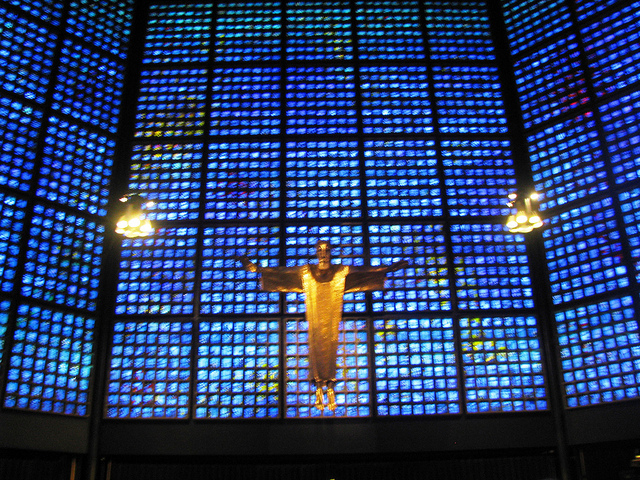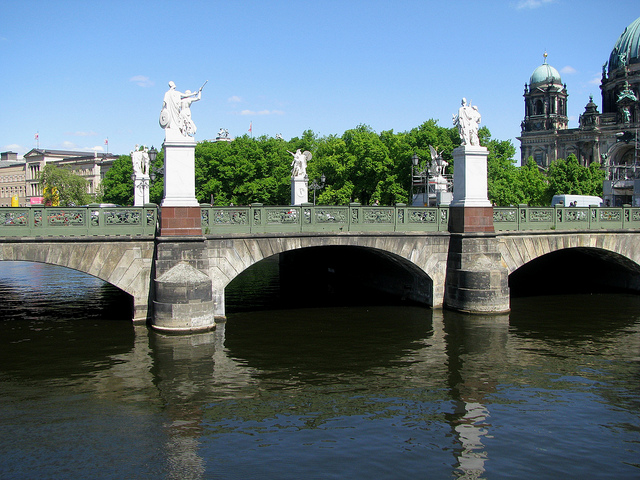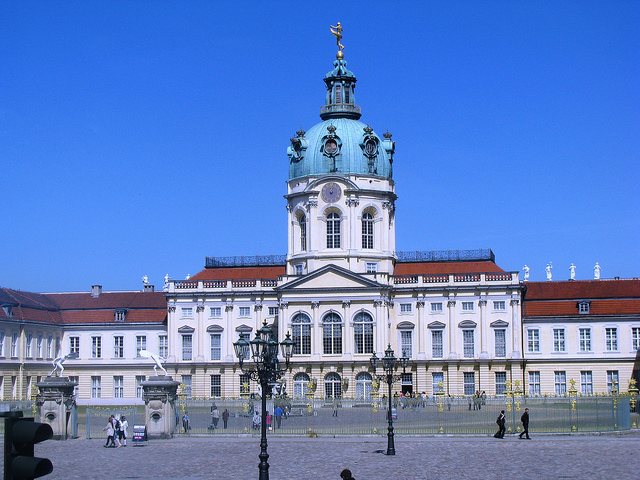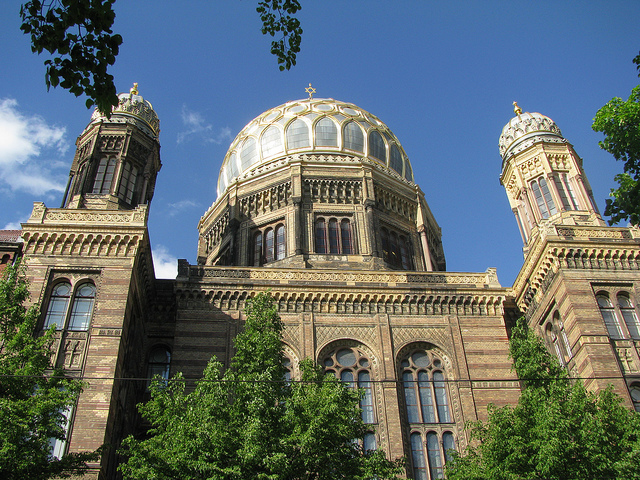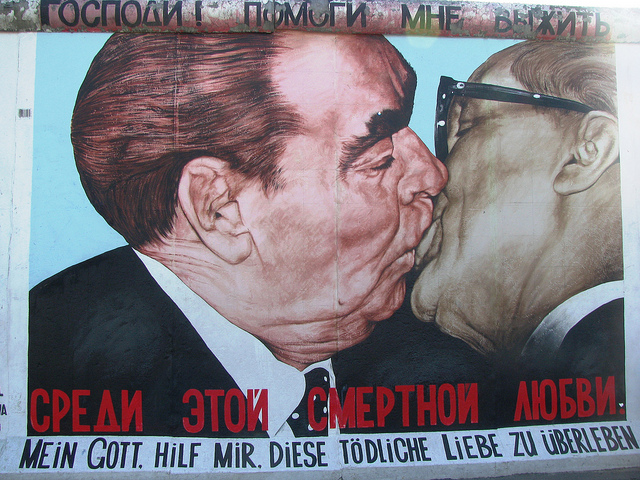May 2, 2011 started as a rather rainy and cool affair in Berlin. I hopped back on the S-Bahn and went from East Berlin’s Lichtenberg district to the former heart of West Berlin: the Kurfürstendamm area, Berlin’s most popular shopping street. This broad and elegant boulevard is the equivalent of Paris’ Champs Élysées and is home to many upscale fashion designers and boutiques. This elegant avenue celebrated its heyday in the 1920s when it became one of the centres of Berlin’s active nightlife. During World War II, like most of Berlin, the area suffered heavy damages but was quickly rebuilt after 1945 when it became West Berlin’s commercial centre. To this day I remember my brief one-day visit to Berlin in August of 1989, before the Fall the Wall, with the colourful neon lights on Kurfürstendamm that contrasted so starkly with the grey monotony of the former East Berlin. Now it was time to explore this area again, more than 20 years after Germany reunification.
I started my explorations with the Kaiser-Wilhelm-Gedächtniskirche (Kaiser Wilhelm Memorial Church), one of Berlin’s most iconic sights. Actually, I almost couldn’t find it since it was being restored and hidden behind concrete panelling. Built in the late 1800s under Kaiser Wilhelm II, this neo-Romanesque church was named after his grandfather, Kaiser Wilhelm I and the church was officially consecrated in 1895.

In 1943 the church was almost completely destroyed by an aerial bomb attack, and only a portion of its tower was left standing. On the ground floor a memorial hall has been created which contains the original beautiful wall mosaics and various artefacts. Beside the old church a new church was completed in 1961 and features magnificent blue stained glass inlays. The Kaiser Wilhelm Memorial Church is a stunning testimonial to the destruction wreaked by WWII and one of Berlin’s most transfixing icons. The jagged and wounded outline of the Kaiser Wilhelm Memorial Church serves as an extremely powerful reminder, warning the world never to walk down this path of devastation again.
On a much lighter note, not far away is the famous KaDeWe (“Kaufhaus des Westens” – “Department Store of the West”), the second largest department store in Europe. It features more than 60,000 square meters (almost 646,000 square feet) of retail space and sells almost 400,000 different items. In addition to its high-end fashions, it is particularly famous for its food court and top-level winter garden which features a huge assortment of delicatessens and a great place to look out over the rooftops of Berlin.

For lunch I walked to the Savignyplatz, an attractive leafy square that features a nice small park that was built in the second half of the 1920s. Most of the area was built up during the late 1900s. The square is dotted with a variety of benches and sculptures and surrounded by several restaurants. Various home decor and fashion stores frame this public space. Shrubs and spring flowers were blooming and the square invites visitors to sit down and enjoy this quiet oasis in the middle of the city.
After a tasty pasta lunch, I hopped back on the U-Bahn to explore one of the most impressive squares in Berlin: the Gendarmenmarkt. Dating from the 17th century, the original square has been restored to its original splendour after extensive destruction during World War II. The square is anchored by the Konzerthaus Berlin, the city’s famous concert hall which opened in 1821. It is flanked by two magnificent cathedrals: the French Cathedral (Französischer Dom) and the German Cathedral (Deutscher Dom), two nearly identical buildings from the early 1700s. A statue of German poet Friedrich Schiller stands right in the centre of this impressive square.

In the late afternoon I had planned to visit one final destination: the Jewish Museum of Berlin which chronicles 2000 years of Jewish history in this city. The museum consists of two buildings: a former courthouse from the 18th century, and a new addition that was designed by world-renowned architect Daniel Libeskind and opened in 2001. The design of the new portion is reminiscent of a distorted Star of David and uses sharp angles, small irregular windows and empty spaces (“voids”) to evoke the tragic history of Berlin’s Jewish community.
One of the voids features an installation called “Fallen Leaves” that consists of 10,000 rough iron faces. A permanent exhibition called “Two Millennia of German Jewish History” portrays German history from a Jewish perspective. At the multi-media Rafael Roth Learning Center, 20 computer terminals invite the visitor to discover German-Jewish history. With its many exhibits and a hands-on interactive learning tools, the museum provides an amazing opportunity to learn about Jewish history in Germany.

After my early evening visit to the Jewish Museum, I walked back all the way to the famous Alexanderplatz with one of Berlin’s most well-known symbols: the TV Tower, built in the 1960s by the former GDR administration. With a height of 368 metres it is the tallest structure in Germany and the 4th tallest free-standing structure in Europe. The tower can be seen from virtually anywhere in Berlin and has a revolving restaurant that now spins twice as fast since its renovation in the late 1990s.
Along the way I strolled through the Nikolaiviertel , the historical heart of Berlin that was reconstructed in the 1980s after suffering heavy damage during WWII. The Nikolaikirche (St. Nicholas’ Church) was built between 1220 and 1230, is the oldest church in Berlin and served as the home of the “Peaceful Revolution” which started the end of the former East German regime. Around the corner I admired the “Rotes Rathaus” (Red City Hall), a magnificent red brick structure that still serves as the home of Berlin’s mayor. It too was heavily damaged and was rebuilt in the 1950s. Many restaurants and bars occupy the cozy spaces on the main floors of buildings in the Nikolaiviertel.

I had spent another full day getting to know Berlin and by 9 pm I headed back to my hotel to get ready for my last day of adventures in Berlin that would feature a bicycle tour through the city’s famous Kreuzberg district.
